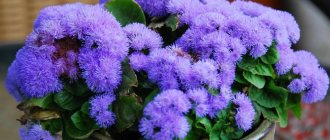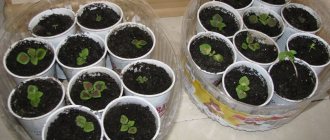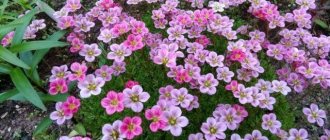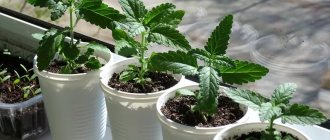Viola is a pretty and delicate plant that can easily fit into any flower arrangement in a garden or vegetable garden. It easily takes root in climate and soil conditions and does not require much time for care.
The best way to get healthy and strong shoots is to plant viola as seedlings
How to grow viola seedlings? Let's take a closer look in this article.
Landing dates according to the lunar calendar
When planting, gardeners all over the world rely on a special calendar – the lunar calendar. It is believed that the Moon has a special effect on plants, causing an increase or decrease in vitality, like the ebb and flow of tides.
This calendar highlights the most favorable and unfavorable days, each month has its own, since everything depends on the date of the full moon and new moon - on these days it is strictly prohibited to do gardening.
So, when to plant viola seedlings? The following periods should be taken into account:
| Month | Favorable days | Unfavorable days |
| January | 17, 18, 19, 23, 24, 25, 26, 27 | 5, 6, 21 |
| February | 6, 7, 8, 11, 12, 13, 14, 15, 16, 17, 23, 24, 25 | 4, 5, 19 |
| March | 12, 13, 14, 15, 16, 17, 19, 20 | 6, 7, 21 |
| April | 6, 7, 8, 11, 12, 13, 15, 16, 17, 29, 30 | 5, 19 |
| May | 8, 9, 10, 11, 12, 13, 14, 15, 16, 17, 21, 22, 23, 26, 27, 28 | 5, 19 |
Another important factor that affects the timing of planting is the climatic features of the region. The territory of Russia is huge, so each region has its own deadlines. Here everything depends on the depth of soil freezing, the abundance or lack of moisture, and solar energy.
These conditions may change from year to year, therefore, starting in early spring, it is recommended to listen more carefully to the forecasts of weather forecasters, who can predict in advance when warming is expected.
Selection of location and conditions of detention
Growing viola is possible only if certain conditions are met. Let's find out what is needed for the healthy growth of a tricolor violet.
Lighting and location
Viola loves bright sun, but it should not shine on the flowerbed all day. Therefore, it is better to choose a place where the shadow falls on it closer to the middle of the day. You can plant violets near a high fence, against a wall or in the garden.
Temperature
The optimal temperature for growing viola in the garden is +18…+20 °C. But the flower can withstand night cold and even light frosts. And during the day it tolerates heat up to +30 °C and above.
Air and humidity
Flowers thrive in moderately humid air (50-70%). Overwatering can lead to the development of fungal infections. It is better not to place pansies in a draft.
Priming
Tricolor violet likes to grow in humus-rich, loose and moist soils with a neutral reaction. Flowers love it when the soil contains black soil, humus, river sand and high-moor peat. They respond well to the addition of wood ash: it enriches the soil and neutralizes acids in it.
Popular types and varieties
To date, over 100 varieties of viola have been bred. But not all of them are planted on Russian territory. The most popular are the following:
| Variety | Description |
| Wittrock | The most popular and widespread type. It has many colors, and some flowers can be of two or three tones. The height of the plant is small - up to 20 centimeters. |
| Alpensee | It differs in the tone of the buds: they have a rich purple hue with a bright yellow core. In addition, the petals have a velvety texture. |
| Bambini | A variety characterized by rich yellow bud petals with red or brown edges. |
| Crystal Bowl White | As the name suggests, this variety has delicate white shades of petals, and the core of the bud is predominantly yellow. |
| Delta Pure Deep Orange | It has a rich orange color of the petals without veins or inclusions. That is why it received such a name. But the main advantage is the large buds, which are several times larger than other varieties. |
| Firnengold | The variety has rich yellow buds with a brown or red core. |
| Majestic Giant II Scherry | The buds of this variety have petals of rich pink or cherry color. Sometimes the edges of the petals are bordered with a gold stripe. |
| Horned or ampelous | Forms an even single canvas of flowers with a diameter of 4-5 centimeters. Fits perfectly into a flower arrangement. Available in various bud colors. |
| Fragrant | The buds form a neat bush, which will also fit perfectly into any flower idea. The buds are, in most cases, white, purple, blue or pink. |
The conditions that are most optimal for a particular variety are usually written on the packaging of the seeds. It is recommended to study them carefully and compare them with the climatic characteristics of a particular region.
Types of viola
Even before the artificial breeding of decorative varieties, dozens of varieties of viola already existed in nature. And no wonder, because it is found all over the world!
Viola Wittrock
By far the most popular variety of viola, and it is also a hybrid of several species with a tricolor violet. In fact, it was this flower that was originally nicknamed pansies for its characteristic colors. There are dwarf, giant and ampelous varieties.
Photo: versal-sad.ru
Fragrant viola
The most fragrant variety is most reminiscent of classic violets in blue and purple shades. Fragrant viola is a star in perfumery, cosmetology and folk medicine.
Photo: fragrantica.ru
Viola Williams
Another hybrid, but based on the Wittrock viola itself. The height of the bushes reaches 30 cm, and the diameter of the flowers is up to 4 cm. The colors are bright and variegated, but without the characteristic eye spots.
Photo: bloomingarden.ru
Horned viola
This is a perennial species with a characteristic growth near the bud, which gives rise to its unusual name. The bushes grow up to 25 cm and are densely covered with flowers 5 cm in diameter.
Photo: agbina.ru
Moth viola
It is also called Sororia, and is a small primrose up to 20 cm in height. With proper care at the end of summer, the butterfly viola can bloom again.
Photo: prolisok.com.ua
spotted viola
In addition to one- and two-color varieties, there are spectacular variegated forms. Terry varieties and varieties with corrugated petals are especially good.
Photo: fotoload.ru
Pushkinia (60 photos): types, planting and care in open ground
Advantages and disadvantages of growing through seedlings
Viola is usually planted through seedlings. This method is considered the most favorable for this plant, since it prevents the death of sprouts in unfavorable environmental conditions.
Young shoots are significantly affected by frost, strong and cold winds, abundance or lack of moisture and solar energy. In turn, seedlings will help prevent this.
The method of growing seedlings has several significant advantages:
- Seedlings allow you to get healthier, more beautiful plants that can take root in open ground.
- Easy to grow and care for. The gardener does not require any special skills or experience.
- The ability to create a unique composition from several varieties. Experienced gardeners can even create different designs or patterns.
The only disadvantages of the seedling method include the additional costs of purchasing cassettes, soil, and various mineral mixtures for bait.
Viola – photo
A blooming viola carpet looks very fantasy. And all thanks to the unusual colors of modern decorative varieties!
Photo: agbina.ru
Photo: zen.yandex.ru
Photo: dachnyedela.ru
Photo: agbina.ru
Photo: 2sotki.ru Photo: commons.m.wikimedia.org Photo: fotokto.ru
Photo: mykaleidoscope.ru
Photo: fb.ru
Photo: sbermegamarket.ru
Photo: pinterest.ru
Photo: fotoload.ru
Photo: master-electrician.ru
Photo: flovital.ru
Photo: semenafermeru.ru Photo: sady-msk.ru
Photo: pinterest.es
Photo: pinterest.ru
Photo: proprikol.ru
Photo: pxhere.com
Photo: needpix.com Photo: pixabay.com
Photo: 5-nt.ru
Photo: wallbox.ru
Photo: gifok.net
Photo: za.pinterest.com
Did you like the post? Subscribe to our channel in Yandex.Zen, it really helps us in our development!
Step-by-step instructions for sowing seedlings
There are several planting schemes depending on the time of year:
| Sowing seeds | Flowering time |
| Go straight to the garden or vegetable garden in winter | One of the most common methods. The seeds are hardened in the ground, and in the spring they germinate and flowering soon begins. |
| For seedlings, starting in early March | Flowering occurs two to three months after planting the seeds for seedlings. |
| Directly into the garden or vegetable garden in spring or early summer | Planting begins after night frosts stop and the air temperature becomes constant. The first buds will appear in August-September. After flowering, the plants do not need to be removed, if they are perennial, then they will germinate on their own in April of next year. |
The second, seedling, is considered the best because it allows you to get healthy and beautiful plants that are resistant to environmental conditions.
Let's consider this method in more detail.
Selecting a location
For this plant, choose a sunny, warm place. The best option is a window sill on the south side of the house, where the sun shines most of the time.
If the conditions of the house do not allow such a window sill to be highlighted or cloudy, cloudy weather prevails in the region, then special lamps are used as a light source. They can be purchased at a special gardening store.
The service life of such lamps is about 10-20 years, so the investment will be justified.
Seed selection and preparation
The bag of seeds must be intact, neat, and free from defects and damage. The seeds themselves must also be clean, free from stains and inclusions, and free from the smell of rot and traces of bacteria and insects.
Before planting, the seed must be prepared:
- First of all, they are disinfected, all pathogenic microorganisms, if any, are removed. For this purpose, use a weak solution of potassium permanganate, into which the seeds, wrapped in several layers of gauze, are immersed overnight;
- half an hour before planting, the seeds are placed in growth stimulants. These are special preparations that can be found in gardening stores.
Seed growth stimulator before planting
The quality of the seed largely depends on the quality of the plants.
A healthy viola adapts more easily to environmental conditions and is less susceptible to diseases and pests.
Soil selection and preparation
For seedlings, a ready-made soil substrate for flowering plants is usually used. It is available in gardening stores and is intended specifically for seedlings. The main advantage of the finished composition is the balance of vitamins and minerals necessary for the development of the plant.
Another option is to make your own substrate for planting. It is recommended to mix equal parts of soil from the garden, peat and sand. Experienced gardeners recommend growing seedlings in clean peat, as they believe that this will produce high-quality shoots.
Before planting the material, it is recommended to treat the soil mixture with foundationazole. It will destroy all pathogenic bacteria that can be dangerous to young seeds
Selection of capacity
Both individual containers and one large container are suitable for planting seedlings. But as the young shoots grow, they will have to be planted in separate jars, if they initially grew in one common one.
There must be drainage holes at the bottom of the container to drain liquid.
It is recommended to lay a layer of pebbles or coarse sand as the bottom layer. This will also save the root system from rotting
Direct sowing of viola
The planting order is no different from other plants, so gardeners, even beginners, will not have any problems.
How to sow viola for seedlings? The sequence of actions is as follows:
- prepare everything you need: purchased substrate or homemade soil, individual or shared containers, a wooden stick or toothpick, seed growth stimulator, a spray bottle with water at room temperature;
- soak the seeds in a growth stimulator for 20-30 minutes;
- While the seed is being prepared, make drainage holes at the bottom of the containers, if there are none;
- cover the first layer with coarse gravel or sand;
- pour soil over the sand, leaving 1-2 centimeters on top;
- using a wooden stick, transfer the seeds to the substrate;
- sprinkle on top with a layer of soil 5-7 millimeters thick;
- Sprinkle the surface of the substrate with water.
Cover the container with the seed with polyethylene or cling film. Now the seedlings are ready, all that remains is to put them in a warm place and take care of them in a timely manner. How to do it? Let's take a closer look.
Description of the plant
The pansy flower (Víola tricolor) belongs to the violet family and has several names:
- tricolor violet;
- Ivan da Marya;
- brother and sister;
- viola;
- field brothers;
- half-color;
- axes;
- three-flowered
This plant is annual or biennial, reaching a height of 10-30 cm. Distributed in Western Siberia, Iran, and Turkey. For more than 100 years it has been found throughout Europe, where it grows in meadows, fields, pastures, roadsides and gardens. This herb produces many seeds that germinate quickly, giving the appearance that tricolor violet is a perennial plant.
Botanical description
| Characteristic | Photo |
| Heavily covered with foliage, branching stems reach a height of half a meter. The leaves are sessile, with a notch, the shape varies depending on the location on the stem: the lower leaves are ovate, the upper ones are elliptical with long petioles. | |
| Flowering period: May – November. Flowers reach sizes of 1-2.5 cm. The inflorescence is in the form of a brush. The calyx is five-leaved. The upper petals are larger and purple. The middle ones are similar to the top ones, but lighter. The lower petal is white or light yellow. | |
| The fruit is a three-chamber egg-shaped capsule. Yellowish or brownish small seeds fall out of ripe fruits and are then carried by ants. |
Attention! The tricolor violet is easy to confuse with the field violet - the wildflower flowers are smaller, and the petals are equal to the length of the sepal sections and are usually colored white-yellow, sometimes only with an admixture of purple. The tricolor violet is brighter in color.
Photo. On the left is a field violet, on the right is a tricolor
How to care for pansy seedlings
Proper care of seedlings allows you to get beautiful and healthy plants that easily adapt to open ground conditions. But it is important not only to plant the viola correctly, but also to care for it in a timely and competent manner. To do this, you must complete the following steps:
- Viola loves light and warmth. Therefore, it is recommended to keep cassettes with young shoots on the windowsill on the south side of the house. If this is not possible, then ultraviolet lamps can come to the rescue.
- Immediately after planting the seeds in the ground, they are covered with cling film or polyethylene. This allows you to create a greenhouse effect and accelerate germination. But every day the film needs to be removed for 10-15 minutes for ventilation. Better - twice a day.
- Viola does not like excess moisture, as well as its lack. Therefore, it is necessary to water the seedlings as the soil dries out. An abundance of water can lead to diseases of the root system and plant rotting.
- After the first two leaves appear from the ground, the seedlings must be planted in individual containers, if the seeds were initially planted in a single container. The main thing in this matter is accuracy. It is necessary to carefully pry up the sprout along with a lump of surrounding earth and transplant it to a new place.
If you care for the seedlings correctly, then within one or two weeks you will be able to observe young, and most importantly, healthy shoots.
If the seeds do not germinate, most likely the care rules were violated. Less commonly, the cause is an excessively thick layer of soil above the seeds or poor-quality seed material.
Fragrant viola or fragrant violet (Viola odorata)
Viola fragrant is a perennial plant whose flowers have a pleasant aroma. Due to this, fragrant violet extract is used to create perfumes and cosmetic products. Viola odorata is also cultivated as an ornamental plant. However, acquired varieties, after several years of cultivation, often run wild.
Fragrant violet has not only a decorative appearance, but also a wonderful aroma
The leaves of the fragrant violet are round, with a serrated edge. Flowers, up to 2 cm in diameter, are located on long thin stems. Species forms are painted in purple, blue, and white tones. Cultivars can be red, yellow, purple, pink.
The fragrant violet blooms in April and early May. A second wave of flowering is possible - at the end of summer.
The size of the fragrant viola bush is almost dwarf - up to 15 cm. But, if you plant several specimens together, you will get a wonderful lush and dense cushion. Due to its decorative properties, fragrant viola is grown in pots on balconies, flower beds, flower beds and borders, in mixborders and on alpine slides.
The following varieties of fragrant violets are very popular in culture:
- Coeur d'Alsace – pink (salmon) flowers, very fragrant;
- Alba - pure white simple flowers, with a delicate aroma;
- Ashvale Blue - large white double flowers with blue spots on the edges of the petals;
- Marie Louise - blue double flowers with a white center, very fragrant;
- Lydia Groves – single large pink flowers, sweet scent;
- La France – flowers are large, purple, simple in structure;
- Orchid Pink has simple pink-purple flowers with pale blue stripes in the center.
How to plant viola in open ground correctly
The viola is transplanted to open ground starting in mid-May. The main rule is to focus on weather conditions, make sure that there are no night frosts, since they are destructive for young shoots.
Planting in open ground has its own characteristics. Let's take a closer look at the order and main key points.
Preparing seedlings
Proper preparation will allow you to get healthy, strong plants that can easily survive transplantation to open ground and adapt faster to a new location.
Preparing seedlings includes only two points:
- Feeding. About two weeks before the planned transplant to open soils, it is recommended to add mineral fertilizer to the soil for flowering plants. It can be purchased at a gardening store. For seedlings, it is recommended to take fertilizer in liquid form - this makes it easier to determine the desired concentration. Liquid vermicompost works well.
- Hardening. In order for young shoots to quickly adapt to open ground conditions, they need to be hardened off. For this purpose, approximately one to two weeks before the intended planting, it is necessary to take the cassettes with seedlings outside for several hours: in the first days - for 2-3 hours, in subsequent days - for 5-7 hours.
These rules will allow you to obtain high-quality seedlings that can easily adapt to a new location and become a beautiful and healthy plant.
Selecting a location
If viola seedlings love the sun, then the leaves of an adult plant may burn out from solar energy.
It is recommended to plant seedlings in partial shade: a place where part of the day is dominated by sun and the other part by shade. Places under large trees or shrubs with large flowers are ideal for planting. The main thing is to follow the rules of the neighborhood so that other plants do not interfere with the development of the viola.
The soil in the future location should be light, loose, breathable, drained and nutritious - all this affects the quality of future plants. That is why it is recommended to dig up the garden with the addition of crushed charcoal and humus about a month before the intended planting.
You can also apply complex mineral fertilizer - nitroammophoska.
Landing technology
The planting scheme for viola is no different from other plants, so even a novice gardener can cope with this work. The sequence of actions is as follows:
- make holes of small diameter every 20-25 centimeters;
- put a small amount of vermicompost into each hole;
- using the transshipment method, move the young shoots into the recesses;
- cover with soil and compact carefully;
- water the planted plants.
It is also recommended to sprinkle the surface of the earth with ash - this will protect young shoots from various diseases and pests
Feeding and protecting viola from parasites
Pansies should be fed with mineral fertilizers once or twice every 30 days. This will depend on the quality of the soil. It is strictly not recommended to use organic fertilizers!
- For fertilizing, use 30 grams of superphosphate fertilizer or saltpeter per square meter.
- The main pest of viola is powdery mildew. Its appearance is provoked by the excessive presence of nitrogen in the soil or insufficient watering.
In this situation, watering with a solution of soda ash with the addition of laundry soap is used. Flower growers also recommend Fundazol. It is also used to combat botrytis fungus and blackened stems in plants.
Caring for flowers in open ground
Viola needs constant care. It will help the plant quickly adapt to open ground and get used to climatic conditions.
The rules of care are as follows:
- Water as the top layer of soil dries out. Excessive amounts of moisture can lead to diseases of the root system, and too little can lead to yellowing of the foliage;
- After each watering, he recommends loosening the soil around the plant;
- promptly remove weeds near the viola;
- Feed the plant twice a season with complex mineral compounds, for example, “Agricola” or “Fertika Lux”;
- It is recommended to cut off buds that have stopped flowering.
Proper care will help you avoid many problems, diseases and pests.
Home care
Planting and caring for perennial viola is not difficult , but the plant requires certain conditions. For abundant flowering, it requires bright but diffuse lighting. Direct sunlight causes the soil to dry out.
Watering should be daily and plentiful. The viola flower does not tolerate excess moisture, which can cause rotting of the leaves and the development of root rot.
Regular application of mineral fertilizers will help prolong flowering. Mineral compositions are applied twice a month. It is recommended to use complex formulations for feeding. Viola flowers do not respond well to the application of organic fertilizers.
Plantings should be weeded regularly, removing weeds that deprive the plants of moisture and light. In order to prolong flowering time, dried flowers should be removed. Loosening the soil enriches it with oxygen and promotes the growth of flowers, and is also a means of preventing the development of certain diseases.
Possible problems
Viola may be susceptible to pests. Aphids, spider mites, powdery mildew or stem rot are especially common. The action of pathogenic microorganisms slows down the growth and development of flowers, they lose their aesthetic properties and become inconspicuous.
Viola is treated with special compounds - insecticides, which can be purchased at a gardening store.
Viola will become a real decoration of the garden and will fit into any flower arrangement. The main thing is to plant seedlings in a timely manner and care for them, taking into account all the recommendations given in the article.
Pest and disease control
Natural types of viola have excellent immunity, but garden forms often suffer from fungus. The most dangerous problems are blackleg and root rot, which occur in both seedlings and adult plants. The affected flowers will simply have to be destroyed, and then dry the soil and sprinkle it with coal or ash.
Spotting, rust and powdery mildew are less common. They are easily recognized by spots and plaque of different colors and shapes. And you can still fight this fungus! Remove diseased leaves and shoots and treat the flowerbed with fungicides.
Viola is very fond of spider mites and aphids, which drink the vital juices of the plant. In small quantities, a soap solution helps, but in larger quantities, insecticides are already needed. It's the same with slugs, just first collect all the pests you notice by hand.
Photo: pixnio.com
Clarkia (50 photos): types, care and planting in open ground
When to plant
Sowing dates for perennial viola for various regions of Russia:
- October or May (planting before winter or spring) for central Russia;
- September or June for the northern regions of the country;
- November or April for the southern regions.
Annual varieties of tricolor violets are usually sown as seedlings in March (in the north in April, and in the south in February). Then it begins to bloom early. But you can plant viola directly in the ground. Then flowering will begin 1-2 months later. Planting of seedlings or sowing of seeds into open ground is carried out in May (in the north in June, and in the south in April).
Conditions for crops
For the germination of viola seeds, lighting is not important, so you can cover the container with plantings with an opaque covering material (cardboard, plastic).
Temperature and humidity are essential. For successful seed germination, it is necessary to maintain a temperature of +20-23°C, avoiding sudden changes.
An equally important parameter is soil moisture. It should not be allowed to dry out or become waterlogged. Daily ventilation of microgreenhouses for 20-30 minutes and watering when the top layer of soil dries out allows maintaining an optimal level of humidity.
When seedlings appear, the seedlings are placed in a well-lit place and the shelter is removed.
Wintering, collecting seeds
Annual violets do not overwinter. Their aboveground part is removed and destroyed. And perennials are covered with a heap of dry leaves, sawdust or straw. This is enough for the viola to survive the winter.
After flowering, viola forms fruits in the form of boxes. They contain seeds that can be collected and sown next year. The timing of seed collection depends on the flowering time. In any case, you need to wait until the box is completely dry and, when squeezed in your hands, begins to crack and burst, releasing the seeds. At this time they need to be collected. Store seeds in paper bags in a cool, dry place.
Features of cultivation
Viola may suffer from the following diseases:
- powdery mildew (white coating with a gray tint on leaves and flowers);
- black leg (the base of the shoot turns black and dries out, the entire bush dies);
- spotting (brown or almost black spots on the leaves);
- gray rot (affects buds and flowers).
These diseases are caused by various fungi and develop when moisture stagnates in the soil. Treatment of violets consists of removing damaged parts of the plant and treating them with a 0.2% solution of Fundazol. Sprinkling the bushes with wood ash or ground sulfur also helps against fungal infections. As a preventive measure during the rainy season, it is useful to spray pansies with Bordeaux mixture.
Various caterpillars become pests of viola: they eat the leaves of flowers to holes. It is difficult to fight them manually. It is best to treat plants with chlorophos or any insecticide (Aktellik, Inta-vir).
Viola is a compact and relatively low-growing plant. But this does not prevent it from forming large flowers, reminiscent of elegant children's dresses of various colors. It can bloom at any time: spring, summer or autumn. It depends only on when you plant the violet as seedlings or in open ground.











